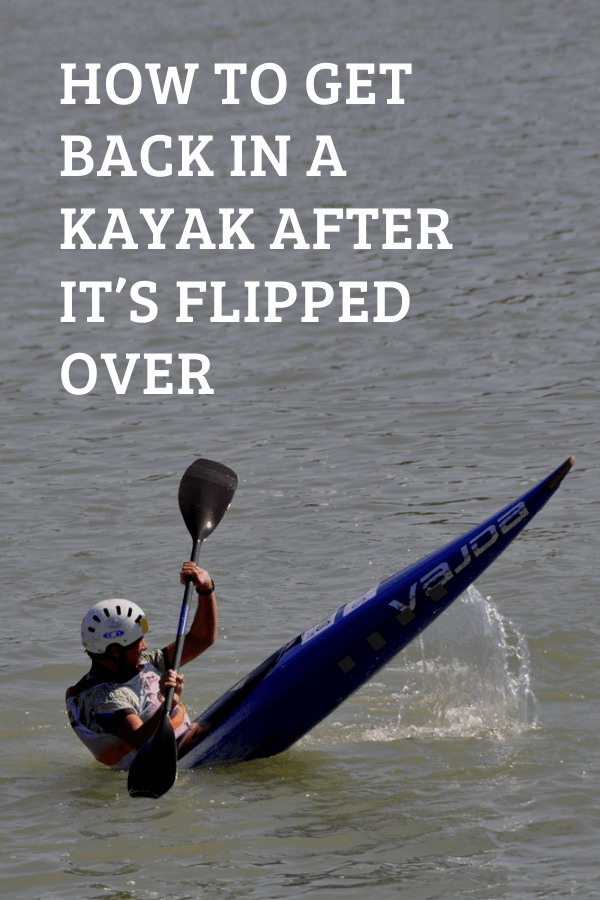Kayaking is an amazing sport. It’s full of opportunities to experience the beauty of nature on a placid lake or even in the thrills of whitewater running on a fast-flowing river. There are, however, two essential facts of kayaking that can’t be escaped: your kayak is on water, and eventually it will flip over and dump you in that water.
An accidental capsize is nothing to worry about, though, as it happens to every kayaker. Besides, taking an unplanned swim is just part of the sport!
That being said, it is important that you know what to do if your kayak flips? You should be aware of the techniques to get you back into your kayak quickly and safely.
To help out, we’ve put together this guide in detailing what to do when your kayak does flip over and how to get back into it.
What Kind of Kayak Is It?
The type of kayak you are in makes a significant difference in how likely you are to flip over. It also determines what the technique is for getting back in once it has flipped over. To make things as clear as possible, we’ve highlighted the difference between the two main types of kayak and how to go about getting back into both.
Sit-On Kayaks
Sit-on kayaks are normally recreational models, with a wide beam that makes it difficult to flip them over. Because you sit on top of the hull rather than in it, your center of gravity is higher, meaning the kayak is more like to capsize due to sudden shifts in weight.
Generally, it’s easier to get back into a sit-on kayak because there is no internal space to bail water out of, no spray skirt to deal with, and it’s much easier to get your legs situated.
Sit-In Kayaks
To many beginners, sit-in kayaks might seem more unstable and more likely to capsize. Because of the position of your body inside the hull, though, your center of gravity is lower and makes it harder to flip your kayak over through sudden motions of your body.
There’s more to think about when you flip over in a sit-in kayak than with a sit-on kayak. If you have a spray skirt attached, you will need to know how to exit your kayak while taking that into account. Sit-in kayaks will also take on water, which means you will need to bail your kayak before re-entering it.
How Do I Prepare for a Capsize?
Preventing a capsize is out of the question. It can happen because a wave threw you off balance or maybe you leaned too far to one side.
The best way to stay safe if your kayak flips over, though, is to prepare in advance for that possibility, and to make sure you have the right safety equipment. When you are doing any form of kayaking, it is vital that you wear a personal flotation device (PFD) at all times.
It is also best to understand and practice the techniques of exiting and re-entering your kayak in the water. Many kayaking courses offer lessons that cover these techniques or you can practice them in shallow calm water, although if you chose to do the latter we recommend you take a friend with you for safety’s sake.
Getting Back on Your Kayak
Sit-On Kayak Recovery
Falling Off Your Sit-On Kayak
The first thing to do when your sit-on kayak flips over is to stay calm. Panicking makes you unable to concentrate and can put you in danger.
Your sitting position on the kayak will most likely have you falling sideways into the water. If you do find yourself fully inverted, try to swim a few feet to the left or right to avoid banging your head on your kayak as you surface.
Try to remember to keep hold of your paddle as it makes a handy flotation aid in a pinch and it is your only means of propulsion when you re-enter your kayak. You can get into a tricky situation if it floats away.
Righting a Sit-On Kayak
First, secure your paddle then swim toward your inverted kayak. Kicking your legs to provide thrust, push your torso onto the upturned hull of the kayak and use both hands to grab the edge of the hull on the far side.
Keeping hold of the hull, bring your knees up and lean backwards. Your body weight will pull the kayak over to the point where the shape of its hull will take over and the kayak will right itself.
Getting Back on a Sit-On Kayak
The benefit of a sit-on kayak it that is doesn’t need to be bailed. In the same motion you used to right the kayak, push your upper body into the hull of your ”˜yak.
This time, allow your legs to float up to the surface behind you instead of bringing your knees up and leaning back. Your leveled body will keep the kayak from flipping over.
You can pull yourself onto it until you are lying flat with your center of gravity in the middle of the ”˜yak. Once you feel stable, roll your body around until your backside is in the seat and then swing your legs up.
If you’re having trouble grasping what this looks like, check out this video of the technique in action:
Sit-In Kayak Recovery
Falling Off Your Sit-In Kayak
The recovery procedure for a sit-in kayak is a little more complicated than for a sit-on. This is because the cockpit of sit-in kayak often has a spray skirt attached and, when inverted, the cockpit of sit-in kayak has the tendency to fill with water.
In order to avoid detaching the spray skirt and still prevent the cockpit filling with water, experienced kayakers often attempt to right their kayak with an “eskimo roll,” which involves using movements of the hips and waist, coupled with the buoyancy of the kayaker’s upper body to roll the kayak through 360 degrees and back into the correct position.
This technique requires practice and experience to do properly, so most kayakers will instead perform a “wet exit,” which involves completely exiting the kayak’s cockpit while underwater.
Righting a Sit-In Kayak
Once you have exited your sit-in kayak, secure your paddle, swim to the side of your kayak and grasp the edge of the cockpit.
With a kick of your legs, push up with your arms and flip the kayak up and away from you. If done with the right amount of force, this will push the kayak over to the point where the natural curve of its hull will take over and right the kayak for you.
Getting Back in a Sit-In Kayak
Once your sit-in kayak is the right way up, reach across the it and grasp the far edge of the hull. Let your legs float up behind you and once your body is level, pull yourself onto your kayak until you are laying across it.
This is where it gets a little trickier than a sit-on kayak. Once you are laying across your kayak, you need to flip your body around and slide your legs into the cockpit before your backside hits the seat.
Once you’re in, you’ll probably be sitting in a few inches of water. You will need to either bail out using a sponge or bilge pump, or head to shore to empty out.
If you’re having a little trouble visualizing how this technique works, check out this video:
You’re Now Back on Track
While your kayak capsizing might seem like a big deal, the truth is that it happens to every kayaker and very rarely puts anyone at risk.
The worst you can usually expect is a bruised ego and having to paddle home in wet clothes. By following our guide and checking out our videos, you’ll get to know all the best techniques to get you back on your kayak and paddling in no time at all.
Leave us a comment if you have any additional tips that we might have missed!


